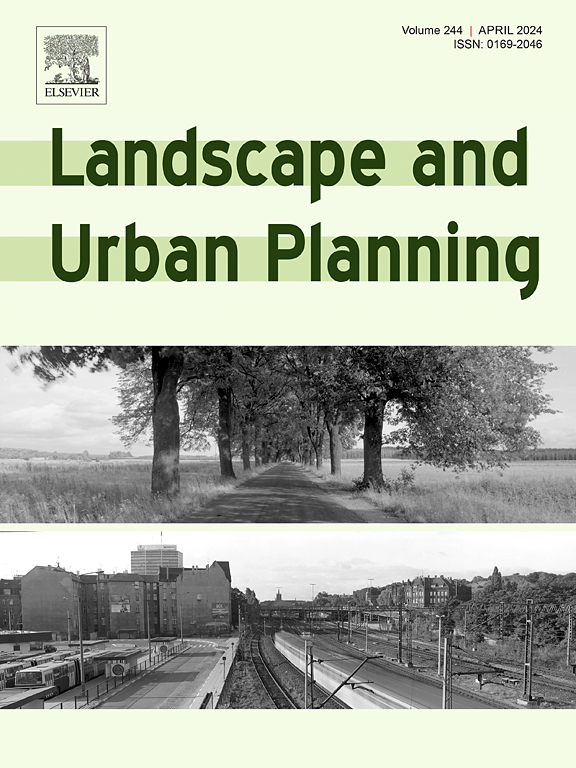城市绿色基础设施多功能性综合评估:斯塔万格的启示
IF 7.9
1区 环境科学与生态学
Q1 ECOLOGY
引用次数: 0
摘要
绿色基础设施(GI)对城市生态系统服务的最佳贡献与其多功能性密切相关。然而,挑战在于多功能性的概念仍需转化为可操作的评估,以评价当前的性能,这对支持空间规划和政策战略至关重要。本研究以挪威斯塔万格市为例,对城市绿色基础设施的多功能性进行了空间评估。该研究采用了一套全面的 27 项功能指标,对 156 个空间单位的类型、年龄、大小和生物物理特征进行了分类。研究表明,功能指标之间的相关性较弱,但揭示了一些潜在的权衡和功能束。值得注意的是,与树木覆盖相关的功能束(如固碳、雨水滞留)与促进措施呈负相关。与公共绿地和公园相关的绿色基础设施类型在功能上有很大的重叠。此外,绿色基础设施单元的特征,如大小和年龄,主要通过对功能指标的影响来影响多功能性。在全市范围内的多功能性方面,我们发现各单元之间存在一些功能的更替和细分,这支持了较大空间尺度上的多功能性。不过,不同地理信息系统类型的平均贡献是相似的。这项研究强调,在设计和管理城市绿地时,需要了解功能指标和功能束之间的相关模式,这对于从协同效应中获益并避免无意的权衡取舍至关重要。本文章由计算机程序翻译,如有差异,请以英文原文为准。
Integrated assessment of urban green infrastructure multifunctionality: Insights from Stavanger
Optimised contributions of green infrastructure (GI) to urban ecosystem services are strongly related to its multifunctionality. The challenge, however, is that the concept of multifunctionality still needs to be transformed into an operationalised assessment to evaluate current performance, which is instrumental in supporting spatial planning and policy strategies. Using the case of Stavanger City (Norway), the study conducted a spatial assessment of the multifunctionality of the urban green infrastructure. The study used a comprehensive set of 27 function indicators estimated for each of the 156 spatial units classified by their type, age, size, and biophysical characteristics. Correlation patterns among indicators and how the average and effective multifunctionality related to unit characteristics were analysed using correlation and multivariate approaches.
The study demonstrated weak correlations between function indicators but revealed some potential trade-offs and function bundles. Notably, bundles related to tree cover (e.g. C sequestration, stormwater retention) had negative relationships with facilitation measures. There was a large overlap in functions between GI types associated with public green spaces and parks. Moreover, the characteristics of green infrastructure units, like size and age, primarily affected multifunctionality through effects on function indicators. Regarding the city-wide multifunctionality, we found some turnover and subsetting of functions among units, supporting multifunctionality at larger spatial scales. However, the average contributions from different GI types were similar. The study highlights the need to understand correlation patterns among function indicators and function bundles as critical to benefit from synergies and avoid unintentional trade-offs when designing and managing urban green areas.
求助全文
通过发布文献求助,成功后即可免费获取论文全文。
去求助
来源期刊

Landscape and Urban Planning
环境科学-生态学
CiteScore
15.20
自引率
6.60%
发文量
232
审稿时长
6 months
期刊介绍:
Landscape and Urban Planning is an international journal that aims to enhance our understanding of landscapes and promote sustainable solutions for landscape change. The journal focuses on landscapes as complex social-ecological systems that encompass various spatial and temporal dimensions. These landscapes possess aesthetic, natural, and cultural qualities that are valued by individuals in different ways, leading to actions that alter the landscape. With increasing urbanization and the need for ecological and cultural sensitivity at various scales, a multidisciplinary approach is necessary to comprehend and align social and ecological values for landscape sustainability. The journal believes that combining landscape science with planning and design can yield positive outcomes for both people and nature.
 求助内容:
求助内容: 应助结果提醒方式:
应助结果提醒方式:


